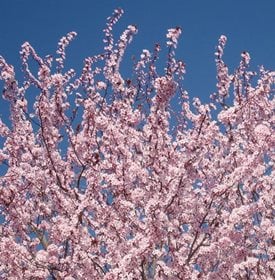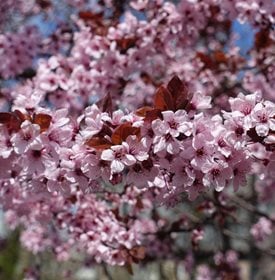Purple-Leaf Plum Tree: Growing and Caring for Ornamental Plums
Add a splash of color and contrast to your yard or garden with purple-leaf plum treesPurple-leaf plum trees, also called cherry plum trees or flowering plum trees, can add interest to your yard or garden with their dark red to purple foliage and abundance of white to light pink spring blossoms. Purple-leaf plums are medium-sized, deciduous trees primarily used for ornamental purposes.
- GROWING PURPLE-LEAF PLUM TREES
- PICTURES OF COMMON VARIETIES
- DESIGN TIPS
- IS PURPLE-LEAF PLUM INVASIVE?
- IS PURPLE-LEAF PLUM FRUIT EDIBLE?
GROWING PURPLE-LEAF PLUM TREES
Zones:
Generally, zones 4-9, with most varieties doing best in zones 5-8.
Mature Size:
25’ high and 25’ across.
Growth Rate:
Medium, about a foot or two per year.
Exposure:
For best foliage color and blooming, purple-leaf plum trees should be grown in full sun to only partial shade. Leaves will not reach their full, rich color potential in shade and will turn almost green.
Water:
Purple-leaf plum trees need regular weekly watering. They are moderately drought-tolerant once established, but may need additional deep watering in summer heat.
Pruning:
Little pruning is needed other than to remove dead or diseased branches, and should be done after flowering. Prune in mid-summer if silver leaf is a problem.
Problems, Diseases, Pests:
Purple-leaf plum trees are known to be susceptible to a large number of diseases including black knot, leaf spot, die back, leaf curl, powdery mildew, root rot and fireblight. They are also susceptible to pests such as borers, aphids, scale, leafhoppers, caterpillars, tent caterpillars, Japanese beetles, and spider mites. These threats can also contribute to its relatively short life span of 20 years or less. Fruit drop can be a nuisance with the large amount of small fruit produced. If you're concerned about these issues, a good alternative is 'Forest Pansy', an Eastern redbud with deep purple foliage.
PICTURES OF COMMON VARIETIES
DESIGN TIPS
- Perfect choice as single specimens or in small groups. Due to its strong effect, can be overpowering if too many are used in a small area.
- Dark red and purple foliage provides contrast in the garden.
- Excellent in Japanese-style gardens.
- Locate in an area where fruit drop will not be a nuisance — away from patios and walkways.
- Three-season attraction with early spring flowers and colorful foliage with variations of bronze, red, and dark purple leaves through the seasons.
IS PURPLE-LEAF PLUM INVASIVE?
Prunus cerasifera can be quite invasive in specific areas of the country. Even if you are diligent about cleaning up the fruit, birds can spread them by carting away the fruit and then dropping the seeds. Other animals, such as rats, opposums, raccoons and foxes, do the same thing.
If you live in one of these areas, consider choosing a different tree for your garden:
- California: Many counties in the Bay Area, some areas along the Central Coast and some other inland counties in the northern part of the state
- Pacific Northwest: The counties around Seattle, Portland and Boise, as well as numerous other counties in Idaho, Oregon and Washington
- Eastern seaboard: Some counties in Maine, Massachusetts, New Jersey, New York and Vermont
- Other states: Very few counties in Michigan, Montana, Ohio, Pennsylvania, Tennessee and Utah
To see if the purple leaf plum is invasive in your area check out this map from InvasivePlantAtlas.org.
Here are some other trees with similar foliage color:
- Cercis canadensis ‘Forest Pansy’
- Cotinus coggygria ‘Grace’
- Acer palmatum cultivars such as ‘Wolff’ (Emperor 1), and ‘Bloodgood’
- Fagus sylvatica ‘Purpurea’
- Malus cultivars such as ‘Prairifire’, ‘Purple Prince’, or ’Thunderchild’
IS PURPLE-LEAF PLUM FRUIT EDIBLE?
A precursor to domestic plum and cherry trees, purple-leaf plum trees were named for their fruits before the modern edibles were cultivated. With domestic plums and cherries now readily available, Prunus cerasifera have been classified as an ornamental, although many people still appreciate the fruit they do produce. The small, dark fruit ripens in late summer surrounded by dark purple leaves, making harvesting a challenge. Although they both have an abundance of small white to light pink blossoms in the spring, purple-leaf plum trees can be distinguished from cherry trees by their deep red and purple foliage, and by their fruits.










